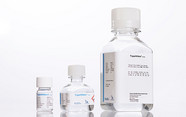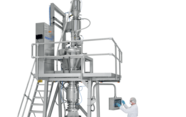
The Potential Pitfalls of Price Controls
As the public demands more be done to address ever-increasing drug prices, government-mandated price controls may seem like the answer. But the evidence suggests that legislation could hamper innovation and potentially have a negative effect on patient health outcomes.
Drug pricing and patient affordability of medicines have been major political points of the 2016 US presidential election. Government-imposed price controls on older generic drugs (1), limits on patient out-of-pocket drug expenses (2), and tighter limits on pharmaceutical pricing overall were major policy positions for both candidates. The drug industry has also been cast in a very negative light during this political cycle. The Pharmaceutical Research and Manufacturer of America (PhRMA) noted that calls to directly control drug prices would “turn back the clock on medical innovation”, restrict patient access to medicines and - according to comments from some health economists – have little effect on stemming drug prices (3).
The issue of high drug prices is also a hot topic in the medical literature among healthcare professionals, especially given the growth of personalized medicines and new specialty medicines (3)(4)(5)(6)(7)(8)(9). The high cost of cancer medications, in particular, has caused oncologists to reevaluate the value framework for these drugs (10). Despite the ongoing discussions, no long-term “solution” on drug pricing has emerged that has broad consensus among public policy officials, politicians, patient advocacy groups, medical and health service researchers, drug industry representatives, and healthcare professionals. But invariably, the “quick and easy fix” option of price controls is raised. While this option may seem publicly appealing, it is important to consider thoroughly the relationship between drug price controls and patient health outcomes.
Drug price controls, according to microeconomic theory, are hypothesized to affect patient health outcomes in two ways:
- Price controls diminish the diffusion of new drug technologies. Assuming that new drug technologies contribute to advances in patient health, the result would be eventual lower health outcomes.
- Price controls decrease incentives for pharma investments in R&D and drug innovation output, which in turn result in eventual lower health outcomes.
The effects of the first relationship are relatively short-term, whereas the effects of the second relationship are seen over the long-term. But what does published evidence have say about these relationships?
Price incentives do matter
Empirical research shows that the shift in pharma R&D to focus on specialty medicines has been driven partly by the greater freedom companies have to price these medicines, particularly when there are few, if any, competing products (11). In addition, there is much evidence to show that a country’s pricing environment impacts the diffusion of new drug technologies. The IMS Institute for Healthcare Informatics has forecast that “in 2020 the use of new medicines, introduced in the prior 10 years, will represent 0.1 percent of volumes in ‘pharmerging’ markets, compared to 2–3 percent in developed markets” (12). The difference in drug utilization will likely result from a combination of both relative price and income effects across markets. Naturally, however, pharma companies will seek diffusion of new drug technology in countries where they can reap higher prices to help pay for R&D (13), (14). For example, companies often choose to avoid countries in Europe with lower prices and stringent price controls, and introduce fewer new drugs after entering a price-controlled market (15). The existence of parallel imports further delays new product launches, meaning that price control policies in one country can have spillover effects in other countries (15).
Another large study across 15 countries found negative new drug price elasticities in the -0.75 to -1.1 range, as well as positive (but small) cross-price new drug quantity effects with respect to old drug pricing (16). (Drug price elasticity estimates into the elastic range – greater than 1 in absolute value – suggests that the diffusion of new drug technology will be hampered by an environment that creates higher price sensitivity.) This study is unique and interesting as it also captured the effects that promoting older drugs have on new drugs – promoting older drugs can have a significant negative impact on new drug market share.
A second study examining 642 new drugs in 76 countries, from 1983 to 2002, found a robust relationship between patent and price regulation effects, and the diffusion of new drugs – in the manner predicted by economic theory (17). That is to say, patents and price controls create a balancing act of conflicting forces. On one hand, patents create government-protected IP monopoly power, thereby rewarding companies taking risks – though at the expense of higher prices. On the other hand, direct price controls lower drug prices but also reduce rewards for innovation. There is no “right” answer here, but rather which trade-off society wishes to accept.
The policy path chosen in the US on this issue is one that tries to balance the trade-off between providing incentives needed for innovation, while at the same time minimizing the negative effects patents create for society – through the creation of patents of limited duration (to make it easier for generic and biosimilar drugs to enter the market) and government subsidies that protect drug access for at-risk groups (Medicare Part D and Medicaid, for example). Whether this approach is better than the more direct approach of regulating drug pricing as done throughout much of Western Europe or Canada depends on the criteria used to evaluate the outcome.
Lastly, another large study done over time and across selected Organization for Economic Cooperation and Development countries found that higher US brand prices relative to other countries contributed to faster diffusion of new drug technologies – but also higher spending per capita on prescription drugs (18).
Overall, the literature demonstrates what economics 101 teaches us – incentives do matter.
Innovation benefits health
What about the more complicated relationship of price controls and pharmaceutical R&D? This is a more indirect relationship and involves a chain of effects. The first link in the chain is the relationship between drug pricing and pharma R&D investment – and a long line of research has shown that drug pricing does impact R&D. The second link is the relationship between R&D and patient health outcomes.
Pharma companies are increasingly focusing on high-cost, specialty medicines – especially those classified as orphan drugs (19) – which require higher incentives to compensate for the added cost and risk involved in development (20). Evidence of the impact of the US’s Orphan Drug Act of 1983 suggests that the incentives enacted through this legislation have boosted the number of drugs for rare diseases. More than 500 drugs for orphan diseases have been developed since the act passed in the US alone, with other countries adopting similar orphan drug programs (21).
Numerous empirical studies show a strong connection between the enactment of price controls and reductions in pharmaceutical R&D investment – leading to decreases in new drug innovation (22, 23). Another study estimated that a 10 percent decrease in the growth of real drug prices caused an approximate six percent decrease in the growth of R&D intensity (24). A more recent study concluded that enactment of patents and exclusivity provisions, while having pros and cons as a policy approach (e.g., the establishment of monopoly drug pricing), still play a dominant role in incentivizing biopharmaceutical R&D (25). Overall, there is an established body of academic literature that establishes the relationship between drug pricing and price controls, and pharma R&D investment and drug innovation.
But what of the second link in the chain – the relationship between the adverse effects of R&D development and drug innovation, and patient health outcomes? Here too, the literature can guide us. The most direct study is one that estimated the effect of real (inflation-adjusted) price declines from price controls on reductions in R&D investment, and then in turn, on life-years lost (in millions) (26). Model estimates determined that a 10 percent, 30 percent, and 50 percent decrease in real drug prices from price controls, decreased R&D investment by 5.8 percent, 17.5 percent, and 29.2 percent, and led to life years lost (in millions) of 40.1, 113.5, and 178.8, respectively. This connection to reductions in life-years lost depends on the relationship between the diffusion and utilization of new drug innovation, and patient health. Pharmaceutical innovation was estimated to increase life expectancy by 1.27 years during the period 2000–2009 for 30 developing and high-income countries (27).
Similar studies have been conducted by the same author showing country life expectancy rising alongside pharmaceutical innovation. However, not all empirical studies show a strong relationship between pharmaceutical spending and life expectancy; for example, one study in Canada found no effect between drug spending, and infant mortality and life expectancy at 65 (28). Economic theory may explain how reduced pharmaceutical R&D and lower diffusion of drug innovation could result in lower health outcomes, but the empirical challenges of determining a robust effect amongst all the other factors that can affect life expectancy and/or health outcomes is a daunting task. While the empirical studies presented here generally show a strong relationship between price controls and patient health outcomes, more research is likely needed to determine the robustness of the effect and its magnitude.
The US and price controls
Given that drug pricing has been a big topic during the US elections, it is possible that the country will see some form of direct drug price controls in the future. Instituting drug price controls would be a policy approach consistent with a populist-oriented Trump presidency. Whether the Republicans in Congress – who now control both chambers and have traditionally voted against such controls – would go along with it remains to be seen. Pressure will be exerted by the progressive wing of the Democratic party, which has gained in influence during this election cycle from the Bernie Sanders run, and will most certainly push for direct government-imposed drug price controls. Yet, the US government already has a number of powerful mechanisms to help control prices. For example, the federal government establishes Medicaid drug pricing based on significant discounts from the best commercial price being offered. It is important to remember that significant market forces affect pricing, from increased branded drug competition and competition from generic entry post-patent expiration (including early patent challenges), to bioequivalent and therapeutic drug substitutions. Concentrated market power is shown to affect drug pricing and utilization by drug wholesalers, large health payers, and dominant pharmacy benefit managers.
What those advocating for drug price controls often fail to recognize is that the pharma industry is undergoing rapid and fundamental changes. The easy disease targets that can be addressed with small-molecule drugs are rapidly vanishing and more incentives, not less, are needed for pharma companies to unlock the solutions to the most challenging unmet medical needs. Complicating the challenge facing drug companies is the fact that both improvements in health outcomes and costs of care will be measuring sticks to determine future rewards from drug innovation. This will be an expensive endeavor, and questions exist as to whether society is willing and able to pay for increases in drug innovation needed to solve these medical challenges – the future is admittedly uncertain.
Various groups have traditionally banded together to advocate against direct drug price controls in the US and to date their efforts have been successful (29). However, the dramatic increases in prices necessary to support drug innovation are straining the coalition. Increasingly, new drugs are being priced beyond the means of both payers and patients. Even for drugs that deliver both extraordinary health outcomes and cost-effectiveness – such as new treatments that cure Hepatitis C and so prevent costly complications – patient access is limited because widespread use would quickly bankrupt healthcare reimbursement systems. At the same time, the current commercial model that companies are using to maintain profitability (mainly through price increases) is clearly unsustainable in the long run (30), (31).
As the public demand that new drugs be more widely available, a complete re-evaluation of the system that determines drug pricing is taking place, with drug price controls being increasingly deemed part of the solution. In light of this, pharma companies must radically re-evaluate the commercial models traditionally used to generate and support the prices of specialty medicines. The shift to focus on specialty medicines means the current commercial model – based on a set of increasingly obsolete market dynamics and less-emphasized drug technology going forward – is rapidly decreasing and will need to be changed. Companies need to be demonstrating improvements in everything they do, along the entire product lifecycle, to produce better health outcomes and lower costs of care. The backlash against drug pricing and greater calls for price controls likely reflects that the industry has not yet effectively delivered on this value-based argument. The good news for the industry is that there is still time for internal changes to strengthen this argument. However, if changes are not made, the politicization of drug pricing and public discontent will mean greater government involvement – with negative effects for the industry and patients. As Milton Friedman, a Nobel Prize-winning economist, once said, “If you put the federal government in charge of the Sahara Desert, in 5 years there’d be a shortage of sand.” The empirical evidence presented here suggests that a more heavy-handed approach by the US government to erect price controls will not promote overall social well-being, but will decrease drug innovation needed to address significant unmet medical needs, and adversely affect patient health outcomes.
George A. Chressanthis is Principal Scientist at Axtria, USA. This article was co-published with Axtria, a big data and analytics company: https://insights.axtria.com/relationship-between-drug-price-controls-and-patient-health-outcomes
- New York Times, “Hillary Clinton unveils plan to address ‘excessive’ increases in drug prices”, (2016). Available at: nyti.ms/2c0jYrh. Last accessed November 23, 2016.
- The New York Times, “Hillary Clinton proposes cap on patients’ drug costs as Bernie Sanders pushes his plan”, (2016). Available at: nyti.ms/2gl6nM5. Last accessed November 23, 2016.
- H Daniel, “Stemming the escalating cost of prescription drugs: a position paper of the American College of Physicians”, Ann Intern Med. 165, 50-52 (2016). PMID: 27018758.
- D Feisher, “Affordable cancer medications are within reach but we need a different approach”, J Clin Oncol, 34, 2194-2195 (2016). PMID: 27161965.
- R Pennington and J Stubbings, “Evaluation of specialty drug price trends using data from retrospective pharmacy sales transactions”, J Manag Care Spec Pharm, 22, 1010-1017 (2016). PMID: 27574742.
- S Ramsey, G Lyman and R Bangs, “Addressing skyrocketing cancer drug prices comes with tradeoffs”, JAMA Oncol, 2, 425-426 (2016). PMID: 26868102.
- D Howard et al., “Pricing in the market for anticancer drugs”, J Econ Perspect, 29, 139-162 (2016).
- M Ingelman-Sundberg, “Personalized medicine into the next generation”, J Inten Med, 277, 152-154 (2016). PMID: 25354249.
- Y Shih et al., “Trends in the cost and use of targeted cancer therapies for the privately insured nonelderly: 2001 to 2011”, J Clin Oncol, 33, 2190-2196 (2016).
- L Schnipper et al., “American society of clinical oncology statement: a conceptual framework to assess the value of cancer treatment options”, J Clin Oncol, 33, 2563-2577 (2016).
- F Pammolli, L Magazzini and M Riccaboni, “The productivity crisis in pharmaceutical R&D”, Nat Rev Drug Discov, 6, 428-438 (2011). PMID: 21629293.
- IMS Institute for Healthcare Informatics, “Global medicine use in 2020: outlook and implications”, Available at: bit.ly/1jb3s88. Last accessed November 23, 2016.
- J DiMasi, H Grabowski and R Hansen, “Innovation in the pharmaceutical industry: new estimates of R&D costs”, J Health Econ, 47, 20-33 (2016). PMID: 26928437.
- J Scannell et al., “Diagnosing the decline in pharmaceutical R&D efficiency”, Nat Rev Drug Discov, 11, 191-200 (2016).
- M Kyle, “Pharmaceutical price controls and entry strategies”, Rev Econ and Stat, 89, 88-99 (2007).
- E Berndt, P Danzon and G Kruse, “Dynamic competition in pharmaceuticals: cross-national evidence from new drug diffusion”, Manag Decis Econ, 28, 231-250 (2007).
- I Cockburn, J Lanjouw and M Schankerman, “Patents and the global diffusion of new drugs”, Am Econ Rev, 106, 136-164 (2016).
- P Kanavos et al., “Higher US branded drug prices and spending compared to other countries may stem partly from quick uptake of new drugs”, Health Affair, 32: 753-761 (2013).
- IMS Institute for Healthcare Informatics, “Medicine use and spending in the U.S.: a review of 2015 and outlook to 2020”, (2016). Available at: bit.ly/2gfcIrh. Last accessed November 23, 2016.
- J DiMasi, H Grabowski and R Hansen, “Innovation in the pharmaceutical industry: new estimates of R&D costs”, J Health Econ, 47, 20-33 (2016). PMID: 26928437.
- M Haffner, “History of orphan drug regulation – United States and beyond”, Clin Pharmacol Ther, 100, 342-343 (2016).
- J Vernon, “Drug research and price controls”, Regulation, 25, 22-25 (2002).
- J Vernon, “Examining the link between price regulation and pharmaceutical R&D investment”, J Health Econ, 14, 1-16 (2005).
- C Giaccotto, R Santerre, J Vernon, “Drug prices and research and development investment behavior in the pharmaceutical industry”, J Law Econ, 48, 195-214 (2005).
- H Grabowski, J DiMasi and G Long, “The roles of patents and research and development incentives in biopharmaceutical innovation”, Health Affair (Millwood), 34, 302-310 (2015). PMID: 25646111.
- J Vernon, “New evidence on drug price controls”, Regulation, 27, 13-14 (2004).
- F Lichtenberg, “Pharmaceutical innovation and longevity growth in 30 developing and high-income countries, 2000-2009”, Health Policy Technol, 3, 36-58 (2014).
- G Guindon and P Contoyannis, “A second look at pharmaceutical spending as determinants of health outcomes in Canada”, Health Econ, 21, 1477-1495 (2012). PMID: 18972325.
- J Colamonico and K Slocum, “In the eye of the beholder: a strategy and policy perspective on prescription drug pricing”, (2016). Available at: bit.ly/2gACGJM. Last accessed November 23, 2016.
- J Rockoff, “Pricey drugs are hurdle for new biotech CEO”, Wall Street Journal, (2016).
- J Walker, “Drug makers raise prices despite protests”, Wall Street Journal, (2016).
George A. Chressanthis is Principal Scientist at Axtria.



















